A Brief History of Computers is long back. The Development of computers started ages ago, computer scientists and researchers built a modern computer to make the task of calculation as easy as it can be.
In the early days people or individuals exchanged goods [Barter System] during the process of exchanging goods, they felt to count and tally them.
So they used and utilized stones or wooden sticks to count, to make it simple and easy before purchasing or buying goods from others.
Slowly and gradually the general population of that age started drawing a line on the sand for the purpose of counting the goods,
It was a tedious process as when the counting number grew lengthy it was very difficult to collect the information on sell and purchase so they stopped.
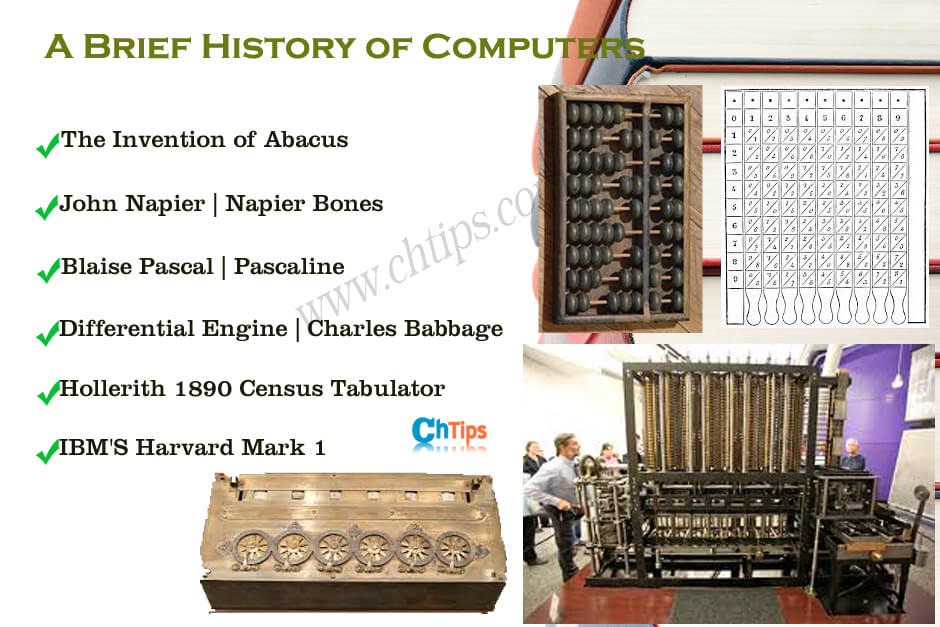
Related Articles
- What is Computer Fundamentals
- Advantages and Disadvantages of Computer
- Basic Block Diagram of Computer
- Main Characteristics of Computer System
- Classifications of Computer
- Advantages and Disadvantages of Mobile Phones
- Advantages and Disadvantages of First Generation Computer
- Advantages and Disadvantages of C Language
- Classification of Computer According to Purpose, Size, Types and Uses
- Features of Fifth Generation Computer
- Fifth Generation Computers are Based on?
- Computer Basic Tutorials
Helpful Video: History of Computers
The Invention of Abacus
The abacus was designed and invented in 3000 BC by the Chinese and later it was modified and changed.
The abacus or a math device was a wooden frame with 9 bars vertically and 1 pole horizontally, each pole bears around 7 beads.
The bar was partitioned into 2 portions upper and lower the upper portion consisted 2 beads and the lower portion consisted of 5 beads.
The upper portion with 2 beads was represented as the number 5, and the lower portion with 5 beads was a single unit or solitary unit.
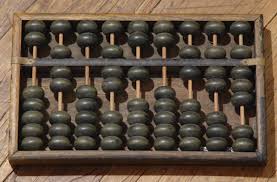
Users used to move the bead from one end to another and the outcome was displayed in the center or focal point of the wooden frame.
People or individuals used to do operations such as addition and subtraction utilizing the beads and their positions.
The abacus or math device is still widely used in some parts of Asia to count, tally, and calculate.
John Napier | Napier Bones
In 1617 A scientist and researcher named John Napier from Scotland invented and developed logarithms.
The machine he invented used to calculate multiplication via performing addition and expansion.
The machine utilized the arrangement of bars and these bars contained digits from 0 to 9.
Which were numbered and were made of bones in this way called Napier’s bones and later John Napier’s development drove straightforwardly to slide rule.
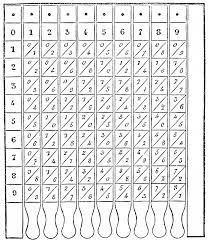
Leonardo da Vinci (1452-1519):: made drawings and illustrations of gear machines but he never built or manufactured any.
Blaise Pascal | Pascaline
In 1962 A celebrated and well-known French mathematician Blaise Pascal at 19 years old developed the main mechanical computing and calculating machine known as “pascaline“.
The machine had a number of teeth and wheels associated with chains. There were 2 models one was 6 wheels and the other was 8 wheels
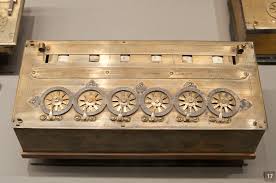
The individuals couldn’t stand to buy 6-wheel machines as they were truly costly. The number was entered into the machine by dialling on the wheels.
As the full turn of the principal wheel was finished it augmented the second wheel. The machine or device was essentially utilized for Addition and multiplication.
1617 Ad Gottfried Leibniz rolled out further valuable improvements in Blaise Pascal’s Machine.
This German researcher assembled a machine that can do all four operations (Addition, Subtraction, multiplication, and Division) and named it a stepped reckoned.
He was the person who supported the utilization of the binary number system which is currently crucial and fundamental to advanced modern-day computers.
Related Articles
- The Five Generations of Computer
- A Brief History of Computer
- Different Types of Computer Systems
- What is a Computer
- 20 Disadvantages of Internet in Points
- Characteristics and Features of Third-Generation Computer
- Differences Between First and Second Generation of Computers
Differential Engine | Charles Babbage
1822: English mathematician and scientist Charles Babbage invented the machine named ” Differential Engine”.
Later Babbage also invented the machine an Automatic computing mechanism and named it “Analytical Engine”.
The Analytical engine was able to store the information and data in its own memory.
This was the crucial and fundamental development of modern-day machines that utilized the essential and basic principle proposed by Charles Babbage.
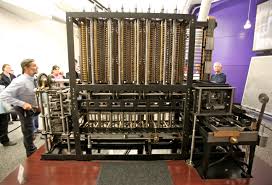
This was a significant advancement in the field of all computer generation, all modern-day computers today utilize a similar idea.
His development is considered a real achievement in the history of computers. Consequently, he is called the “Father of Computers” and his commitment to this field is a breakthrough and a milestone.
A Brief History of Computers
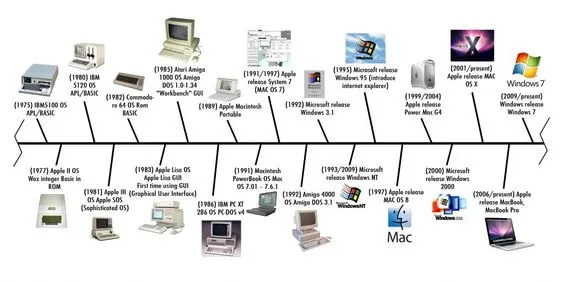
Hollerith 1890 Census Tabulator
Herman Hollerith a German mathematician created and invented the tabulating machine utilizing punch cards for registration in the USA,
The cards used to have gaps when the cards went through machines the machine distinguished the gaps and afterwards the machine could recognize the numbers and later the machine could make important calculations
Second World War Computers During the Second World War numerous nations were fabricating and building new outlines and new designs for Aircraft,
Modern computers were utilized as a part of mystery military operations, and with the help of cutting-edge machines, they were decoding the messages.
In this war PC’s assistance and help were unfathomable in illuminating numerous repetitive and tedious issues that only they could explain,
The computers that were utilized as a part of the war were named Z1 and Z2 Computers German build Konrad Zuse (1910– 1995) built his PC Z1 to Z4 impacted the Second World War.
Related Articles
- What are Input Devices of Computer
- What are Output Devices of Computer
- What is a Computer Virus
- What is Computer Hardware and Software
- What is a Computer Memory
IBM’s Harvard Mark 1
The Harvard Mark I and the ENIAC are both Historical Computers that have implied an incredible arrangement to the advancement in the field of current PC history.
It was the first generation of computers and was called an Automatic Sequence Controlled Computer (ASCC).
They used to perform Addition and increase electromagnetically With no human exertion.
It used to perform three augmentations and one subtraction in 1 second and one increased operation in 1 second ENIAC
Electronic Numerical Integrator and Computer was the principal electronic universally useful computer.
It was a machine that could explain an extensive number of numerical operations with reconstruction.
ENIAC was not ready to store the information or direction it was just created to perform huge numerical calculations.
In 1946, John Mauchly and John Presper Eckert built the ENIAC I (Electrical Numerical Integrator And Calculator).
Their examination was broadly supported by the American military.
The American armed forces required a PC for unraveling mounted guns shooting table which was utilized to set distinctive weapons under any condition for target accuracy
Howard Aiken and Grace Hopper planned and built up the MARK arrangement of PCs at Harvard University.
The arrangement started with Mark-I in 1944.
The machine they assembled was an immense PC you can envision it was 55 feet long and 8 feet high it required a gigantic room or space for convenience it was around 5 tons, and it contained around 7,60,000 pieces.
These sorts of computers were utilized by the US naval force for gunnery and ballistic Calculation.
Vacuum Tubes – 1930 – 1950s
The First Generation Electronic Computers utilized vacuum tubes, vacuum tubes are glass tubes with circuits inside.
Vacuum tubes have no air within them which secures the circuitry
The UNIVAC 1951
The UNIVAC I (Universal Automatic Computer I) was the principal business PC created in the United States.
It was outlined by J. Presper Eckert and John Mauchly, the designers of the ENIAC it was the real disclosure ever.
What are the Four Basic Computer History?
| 3000 BC and 1450 AD | Premechanical Age |
| 1450 – 1840 | Mechanical Age |
| 1840 – 1940 | Electronic Age |
| 1940 – Till Now | Electromechanical Age |
The Five Generations of Computer in Tabular Form
| # | Computer Generations | Timeline | Hardware |
| 1 | First Generation of Computer | 1940-1956 | Vacuum Tubes |
| 2 | Second Generation of Computer | 1956-1963 | Transistor |
| 3 | Third Generation of Computer | 1964-1971 | Integrated Circuit (IC) |
| 4 | Fourth Generation of Computer | 1971-1980 | Microprocessor |
| 5 | Fifth Generation of Computer | 1980- Till Now | Artificial Intelligence |
History of Computer PDF Download
What is the History of Computers in 200 Words?
The invention of computers was around 2000 years ago. The computer technology is developed according to the time and requirements of the users.
There are five significant generations of computers that have evolved according to the functionality and performance of the computer system.
Before, computers were used only for calculation as they were speedy and accurate in deriving the results.
The computer that was extensively used and utilized for calculation purposes is “ABACUS”.
Modern computer systems used modern technology in their development and were extremely fast, accurate, and reliable in performing tasks and jobs presented to them.
Personal computers are prevalent these days as they are more powerful and affordable compared to other previous versions of computer systems.
These personal computers and modern laptops use advanced operating systems that help in executing tasks and operations with more efficiency compared to before.
Improved and advanced graphical and more powerful processing power led to the gaming industry, which boomed recently.
In the 21st century, powerful computers are built with the help and assistance of Artificial Intelligence and Machine Learning.
What are the 4 Types of Computer?
- Super Computer.
- Mainframe Computer.
- Mini Computer.
- Micro Computer.
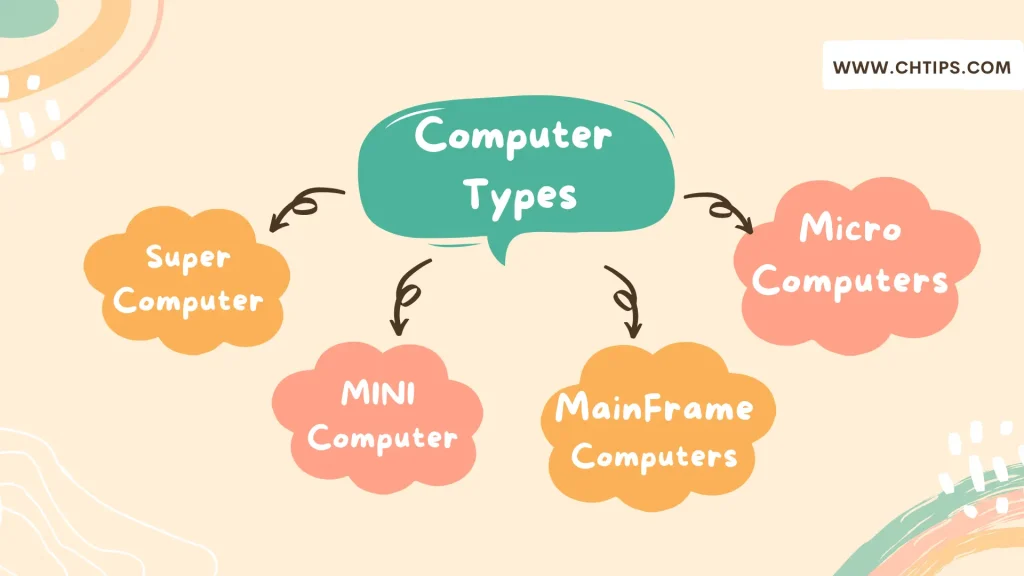
Famous Computer Brands
Frequently Asked Questions [FAQs]
Who is the father of computers?
Charles Babbage.
What’s the full form of computer?
Common Operating Machine Purposely Used for Technological and Educational Research
What is the first computer name?
ENIAC: Electronic Numerical Integrator and Computer
What is the brain of computer?
Central Processing Unit [CPU].
Who is the first programmer?
Ada Lovelace
What is full form of laptop?
Lightweight Analytical Platform Total Optimized Power.
Get In Touch
I have also written and compiled some articles on computers and telecommunications, and please go through them.
I hope you will like reading it.
All the questions and queries related to Explanation on a Brief History of Computers are answered here.
If you have any questions about computer history.
Don’t hesitate to contact me, and if you feel to add, remove or update anything from the article, please let me know in the comment section or via email.
I will be more than happy to update the article. I am always ready to correct myself.
Please share this article with your friends and colleagues; this motivates me to write more related topics.
!!! Thank You For Reading !!! !! GOD BLESS !!